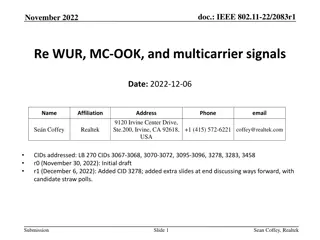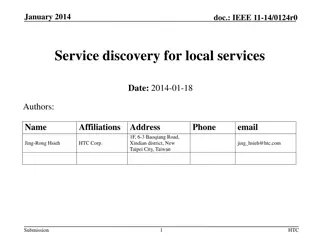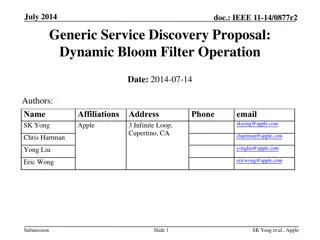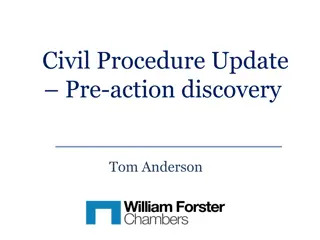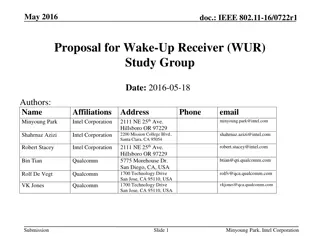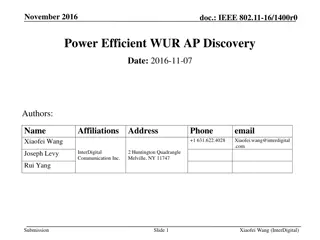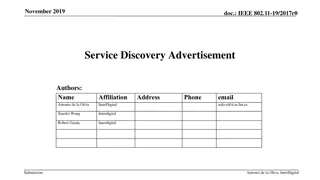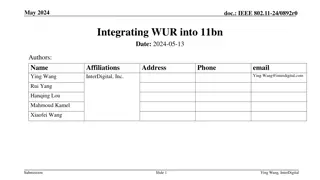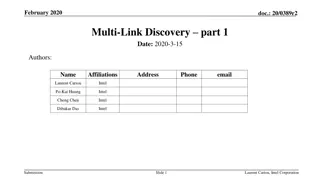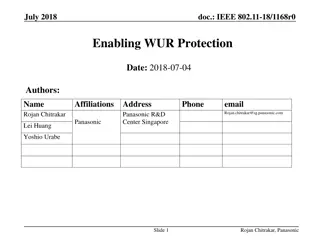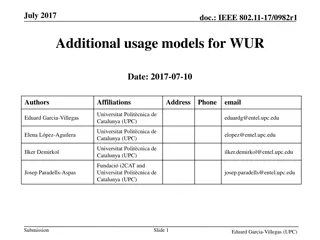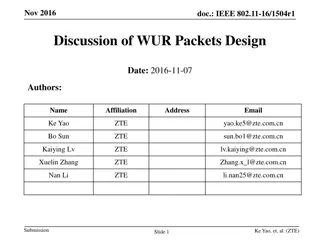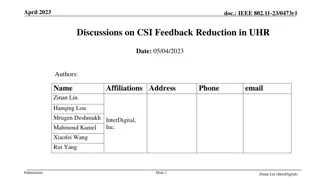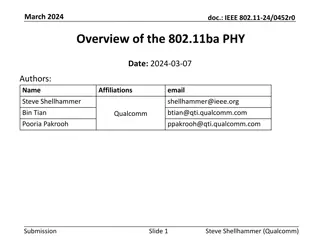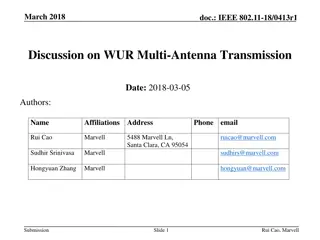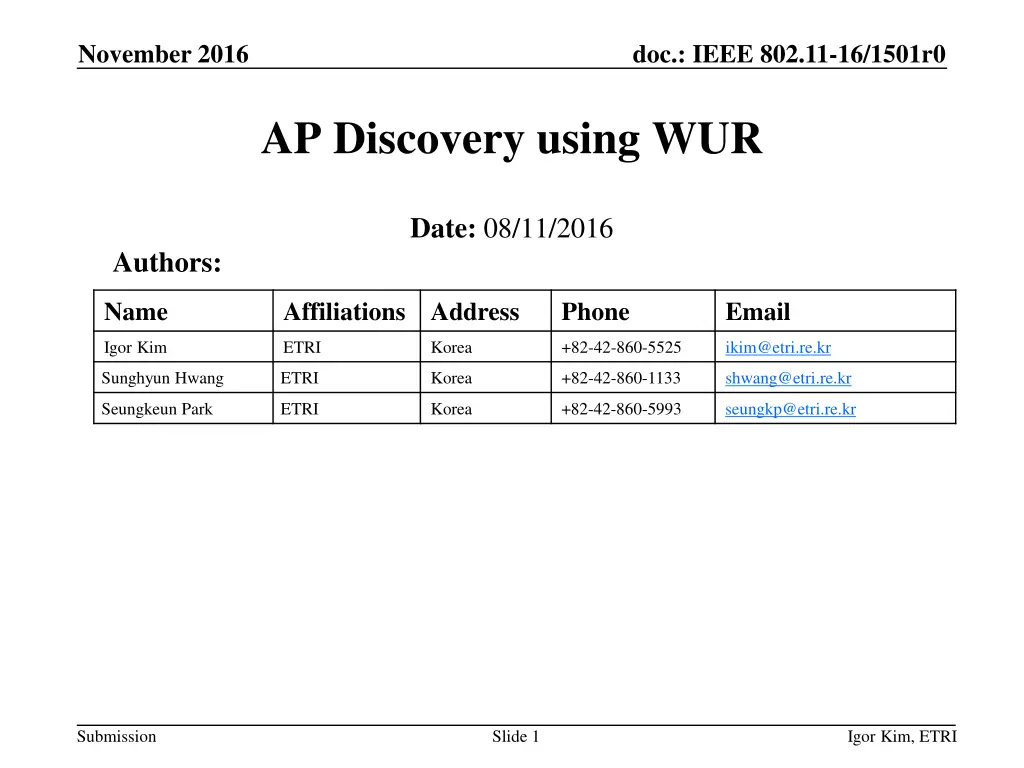
Efficient AP Discovery Method for WUR Equipped Devices
Improve efficiency in AP discovery for WUR equipped devices, reducing power consumption and interference. Addressing the challenges of unnecessary probing and high management frame traffic in congested environments by proposing a method to streamline AP discovery processes. Explore the benefits and conflicts associated with non-WUR and WUR capable devices within AP coverage areas.
Download Presentation

Please find below an Image/Link to download the presentation.
The content on the website is provided AS IS for your information and personal use only. It may not be sold, licensed, or shared on other websites without obtaining consent from the author. If you encounter any issues during the download, it is possible that the publisher has removed the file from their server.
You are allowed to download the files provided on this website for personal or commercial use, subject to the condition that they are used lawfully. All files are the property of their respective owners.
The content on the website is provided AS IS for your information and personal use only. It may not be sold, licensed, or shared on other websites without obtaining consent from the author.
E N D
Presentation Transcript
November 2016 doc.: IEEE 802.11-16/1501r0 AP Discovery using WUR Date: 08/11/2016 Authors: Name Affiliations Address Phone Email Igor Kim ETRI Korea +82-42-860-5525 ikim@etri.re.kr Sunghyun Hwang ETRI Korea +82-42-860-1133 shwang@etri.re.kr Seungkeun Park ETRI Korea +82-42-860-5993 seungkp@etri.re.kr Submission Slide 1 Igor Kim, ETRI
November 2016 doc.: IEEE 802.11-16/1501r0 Introduction Problem statement When mobile devices move outside of the coverage area they still perform channel sensing and scanning wasting battery power Unnecessary probing can bring huge overhead and interference to other devices According to the measurements made in [1] over 75% of packets are management frames in congested environments This contribution describes the AP discovery method for WUR equipped devices (e.g. smartphones with WUR) STA eNB AP AP coverage eNB coverage Submission Slide 2 Igor Kim, ETRI
November 2016 doc.: IEEE 802.11-16/1501r0 Non-WUR Capable Devices Location PCR Operation Inside AP coverage Receiving periodic beacon from AP ON Outside AP coverage No beacon from AP Keep doing AP discovery (increase power consumption) (cons) ON Return into AP coverage Connecting to AP immediately (low latency) (pros) ON Conflicting goals! AP coverage eNB coverage Submission Slide 3 Igor Kim, ETRI
November 2016 doc.: IEEE 802.11-16/1501r0 WUR Capable Devices (1) Location WUR PCR Operation Inside AP coverage Receiving periodic beacon from AP OFF ON OFF ON Outside AP coverage No beacon from AP Power off PCR and power on WUR after Ttimeout No AP discovery (power saving) (pros) (after Ttimeout) ON OFF ON OFF Return into AP coverage PCR is sleeping until WUR detects the non-periodic WUR packet Use of expensive mobile data or increase the latency (cons) (after WUR packet detection) AP coverage OFF ON Still conflicting! eNB coverage Submission Slide 4 Igor Kim, ETRI
November 2016 doc.: IEEE 802.11-16/1501r0 WUR Capable Devices (2) STA can detect AP once receiving non-periodic WU packet Submission Slide 5 Igor Kim, ETRI
November 2016 doc.: IEEE 802.11-16/1501r0 WUR Capable Devices with Periodic WUR Broadcast Packet (1) AP transmits periodic broadcast WU packets Returning back to the same network Location WUR PCR Operation Inside AP coverage Receiving periodic beacon from AP OFF ON OFF ON Outside AP coverage No beacon from AP Power off PCR and power on WUR after Ttimeout No AP discovery (power saving) (pros) (after Ttimeout) ON OFF ON OFF Return into AP coverage Detecting non-periodic WUR or periodic WUR broadcast packet with Tperiod Wake-up the PCR (small latency) (pros) AP coverage (after WUR packet detection) OFF ON Note: Ttimeout and Tperiod are configurable parameters, TBD Non-conflicting! eNB coverage Submission Slide 6 Igor Kim, ETRI
November 2016 doc.: IEEE 802.11-16/1501r0 WUR Capable Devices with Periodic WUR Broadcast Packet (2) Submission Slide 7 Igor Kim, ETRI
November 2016 doc.: IEEE 802.11-16/1501r0 WUR Capable Devices with Periodic WUR Broadcast Packet (3) AP transmits periodic broadcast WU packets Visiting another networks Location WUR PCR Operation Inside AP coverage Receiving periodic beacon from AP OFF ON Inside other AP coverage Receiving periodic beacon from other AP OFF ON OFF ON Outside AP coverage No beacon from AP Power off PCR and power on WUR after Ttimeout No AP discovery (power saving) (pros) (after Ttimeout) ON OFF ON OFF Reenter into AP coverage Detecting non-periodic WUR or periodic WUR broadcast packet with Tperiod Wake-up the PCR (small latency) (pros) (after WUR packet detection) AP coverage OFF ON eNB coverage Non-conflicting! Submission Slide 8 Igor Kim, ETRI
November 2016 doc.: IEEE 802.11-16/1501r0 WUR Capable Devices with Periodic WUR Broadcast Packet (4) Submission Slide 9 Igor Kim, ETRI
November 2016 doc.: IEEE 802.11-16/1501r0 Conclusion Legacy devices and conventional WUR devices cannot perform AP discovery with low power and low latency simultaneously Periodic WUR broadcast packet solves the problem of two conflicting goals Reduce the battery consumption while being away from AP (Power saving) Allows fast discovery of available APs once entering into the coverage area (Low latency) Reduces unnecessary Probe request/response exchange resulting in more efficient resource utilization Submission Slide 10 Igor Kim, ETRI
November 2016 doc.: IEEE 802.11-16/1501r0 References [1] IEEE 802.11-16/0977r0, Measurements of 802.11 Behavior in Different Environments, WNG SC contribution Submission Slide 11 Igor Kim, ETRI

